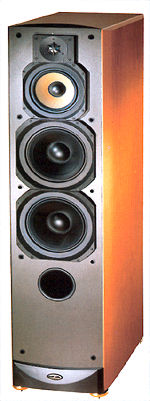| Columns Retired Columns & Blogs |
Paradigm Reference Studio/100 v.2 loudspeaker
It may come as a surprise to relative newcomers to the field of audio, but some loudspeaker manufacturers are manufacturers in only a limited sense. They buy drivers, off-the-shelf or custom-built, from companies like VIFA, SEAS, Focal, etc.; cabinets from a woodworking shop; and crossovers from an electronics subcontractor. While the system design will have taken place in-house, actual manufacturing is restricted to assembling the components, perhaps tweaking the crossover, and final QC. Even some highly successful loudspeaker manufacturers use this approach, which can work well as long as the suppliers do their jobs properly.
 Still, if you want to make certain that a job is done properly, you do it yourself. This means manufacturing drivers, cabinets, and crossovers in-house, which gives you control of every stage of each operation. The downside is that, in order to make this process economically feasible, it must be done on a large scale, with expertise in several areas.
Still, if you want to make certain that a job is done properly, you do it yourself. This means manufacturing drivers, cabinets, and crossovers in-house, which gives you control of every stage of each operation. The downside is that, in order to make this process economically feasible, it must be done on a large scale, with expertise in several areas.
Paradigm is one of the few speaker manufacturers with the resources to take such a "vertically integrated" approach to manufacturing. Virtually every part of every speaker bearing the Paradigm logo is made in their own manufacturing facilities. They even machine the metal molds that they then use to make the plastic parts. The manufacturing enterprise is supported by an extensive research lab that features a huge anechoic chamber, as well as a listening room for double-blind listening tests.
Over the years, Paradigm speakers have acquired a reputation for offering high-quality loudspeakers at very reasonable prices, and the company has the policy of turning profits back into research and increased automation of manufacturing facilities. Most Paradigm speakers fall into the low-priced category (eight of their models sell for less than $400/pair), but their upmarket Reference series is intended to compete with high-end audiophile speakers. The Reference Studio/100 v.2 is the top of this line, and represents everything Paradigm knows about the design and manufacture of loudspeakers.
Description and Design
At first glance, the Reference Studio/100 v.2 seems to be merely a mild cosmetic upgrade of the original Studio/100, reviewed by Tom Norton in August 1997 (Vol.20 No.8). The enclosure's side walls are now curved, and there are a couple of pieces of plastic trim. The speaker is still a ported three-way, and its drivers look much the same.
But there's much more to the "v.2" designation than meets the eye. The speaker has gained 23 lbs—its new, 110-lb heft reflects changes in cabinet construction. Previously, there was one vertical brace, interlocking with three horizontal braces; now there are a second and third vertical brace for added strength. The midrange enclosure used to be a section of the cabinet partitioned off from the rest; now it's a separate MDF chamber attached only to the front baffle, providing better isolation from the woofer. The thickness of the side walls remains the same at ¾" but the grille thickness was changed from ½" to 5/8" to improve the tweeter's dispersion in the lower part of its range.
The tweeter itself has been reworked, with new damping material, a thicker sealing plate for the damping chamber, and a slightly altered magnet structure. The midrange driver has undergone a major re-design. The magnet weight was doubled, improving efficiency and reducing distortion. The voice-coil's diameter has been changed from 1" to 1.5", but the coil still weighs the same because of the use of copper-clad aluminum wire. High-gauss, low-viscosity ferrofluid was added to the midrange driver. Only the woofer was left unchanged; still, its tuning was adjusted slightly through changes in damping material and a 2" increase in port length.
The crossover is still a simple quasi-Butterworth design, with the same crossover frequencies, but almost everything else about it is different. In particular, the midrange crossover is all new, both high- and low-pass sections being revised to take into account off-axis measurements. Similarly, the tweeter high-pass was changed to blend better with the midrange, both on- and off-axis. The crossover's physical layout has been changed, with the midrange and tweeter filters moved to the top of the cabinet and the woofer filter to the bottom, reducing interference between the circuits. The crossover's inductors and resistors are much larger and are now placed farther apart for optimal cooling, and the quality of components is higher.
- Log in or register to post comments




































